Hilbert-Optic Diagnostics of Hydrogen-Oxygen Inverse Diffusion Flame
Abstract
:1. Introduction
2. Experimental Setup
2.1. Theoretical Justification
2.2. RGB-Hilbertogram Processing
3. Analysis of Results
4. Conclusions
Author Contributions
Funding
Conflicts of Interest
References
- Zheng, S.; Qi, C.; Zhou, H. Experimental Investigations of Temperature Distribution in Non-Premixed Flames with Different Gas Compositions by Large Lateral Shearing Interferometry. J. Quant. Spectrosc. Radiat. Transf. 2019, 224, 445–452. [Google Scholar] [CrossRef]
- Song, X.; Wu, R.; Zhou, Y.; Wang, J.; Wei, J.; Li, J.; Yu, G. Understanding the Influence of Burner Structure on the Stability and Chemiluminescence of Inverse Diffusion Flame. Int. J. Hydrogen Energy 2021, 46, 24461–24471. [Google Scholar] [CrossRef]
- Demarco, R.; Jerez, A.; Liu, F.; Chen, L.; Fuentes, A. Modeling Soot Formation in Laminar Coflow Ethylene Inverse Diffusion Flames. Combust Flame 2021, 232, 111513. [Google Scholar] [CrossRef]
- Takagi, T.; Xu, Z.; Komiyama, M. Preferential Diffusion Effects on the Temperature in Usual and Inverse Diffusion Flames. Combust Flame 1996, 106, 252–260. [Google Scholar] [CrossRef]
- Kochergin, D.O.; Abdrakhmanov, R.H.; Lukashov, V.V.; Terekhov, V.V. On the Structure of Direct and Inverse Diffusion of the Hydrogen-Air Flame. Sci. Bull. Novosib. State Tech. Univ. 2016, 62, 195–204. [Google Scholar] [CrossRef] [Green Version]
- Law, C.K.; Chung, S.H. Steady State Diffusion Flame Structure with Lewis Number Variations. Combust. Sci. Technol. 1982, 29, 129–145. [Google Scholar] [CrossRef]
- Utria, K.; Labor, S.; Kühni, M.; Escudié, D.; Galizzi, C. Experimental Study of H2/O2 Downward Multi-Fuel-Jet Inverse Diffusion Flames. Exp. Therm. Fluid Sci. 2022, 134, 110583. [Google Scholar] [CrossRef]
- Cheng, T.S.; Chen, J.-Y.; Pitz, R.W. Raman/LIPF Data of Temperature and Species Concentrations in Swirling Hydrogen Jet Diffusion Flames: Conditional Analysis and Comparison to Laminar Flamelets. Combust Flame 2017, 186, 311–324. [Google Scholar] [CrossRef]
- Yan, Y.; Qiu, T.; Lu, G.; Hossain, M.M.; Gilabert, G.; LIU, S. Recent Advances in Flame Tomography. Chin. J. Chem. Eng. 2012, 20, 389–399. [Google Scholar] [CrossRef] [Green Version]
- Najafian Ashrafi, Z.; Ashjaee, M. Temperature Field Measurement of an Array of Laminar Premixed Slot Flame Jets Using Mach-Zehnder Interferometry. Opt. Lasers Eng. 2015, 68, 194–202. [Google Scholar] [CrossRef]
- Guo, Z.; Song, Y.; Yuan, Q.; Wulan, T.; Chen, L. Simultaneous Reconstruction of 3D Refractive Index, Temperature, and Intensity Distribution of Combustion Flame by Double Computed Tomography Technologies Based on Spatial Phase-Shifting Method. Opt. Commun. 2017, 393, 123–130. [Google Scholar] [CrossRef]
- Grauer, S.J.; Unterberger, A.; Rittler, A.; Daun, K.J.; Kempf, A.M.; Mohri, K. Instantaneous 3D Flame Imaging by Background-Oriented Schlieren Tomography. Combust Flame 2018, 196, 284–299. [Google Scholar] [CrossRef]
- El-Wakil, M.M.; Jaeck, C.L. A Two-Wavelength Interferometer for the Study of Heat and Mass Transfer. J. Heat Transf. 1964, 86, 464–466. [Google Scholar] [CrossRef]
- Konishi, T.; Ito, A.; Kudo, Y.; Narumi, A.; Saito, K.; Baker, J.; Struk, P.M. Simultaneous Measurement of Temperature and Chemicalspecies Concentrations with a Holographic Interferometer and Infrared Absorption. Appl. Opt. 2006, 45, 5725. [Google Scholar] [CrossRef] [PubMed] [Green Version]
- Zhang, H.; Cong, B.; Zhang, F.; Qi, Y.; Hu, T. Simultaneous Measurement of Refractive Index and Temperature by Mach–Zehnder Cascaded with FBG Sensor Based on Multi-Core Microfiber. Opt. Commun. 2021, 493, 126985. [Google Scholar] [CrossRef]
- Huang, Q.; Wang, F.; Yan, J.; Chi, Y. Simultaneous Estimation of the 3-D Soot Temperature and Volume Fraction Distributions in Asymmetric Flames Using High-Speed Stereoscopic Images. Appl. Opt. 2012, 51, 2968–2978. [Google Scholar] [CrossRef] [PubMed]
- Dreyer, J.A.H.; Slavchov, R.I.; Rees, E.J.; Akroyd, J.; Salamanca, M.; Mosbach, S.; Kraft, M. Improved Methodology for Performing the Inverse Abel Transform of Flame Images for Color Ratio Pyrometry. Appl. Opt. 2019, 58, 2662–2670. [Google Scholar] [CrossRef] [PubMed]
- Arbuzov, V.; Arbuzov, E.; Dubnishchev, Y.; Zolotukhina, O.; Lukashov, V. Method of Polychromatic Hilbert Diagnostics of Phase and Temperature Perturbations of Axisymmetric Flames. In Proceedings of the 31st International Conference GraphiCon 2021, Nizhny Novgorod, Russia, 27–30 September 2021; Volume 31, pp. 369–378. [Google Scholar]
- Zarubin, I.A.; Labusov, V.A.; Babin, S.A. Characteristics of Small-Sized Spectrometers with Different Types of Diffraction Gratings. Ind. Lab. Diagn. Mater. 2019, 85, 117–121. [Google Scholar] [CrossRef]
- Ioffe, B.V. Refractometrician Methods in Chemistry; Chemistry: St. Petersburg, Russia, 1983. [Google Scholar]
- Karaminejad, S.; Askari, M.H.; Ashjaee, M. Temperature Field Investigation of Hydrogen/Air and Syngas/Air Axisymmetric Laminar Flames Using Mach–Zehnder Interferometry. Appl. Opt. 2018, 57, 5057–5067. [Google Scholar] [CrossRef] [PubMed]
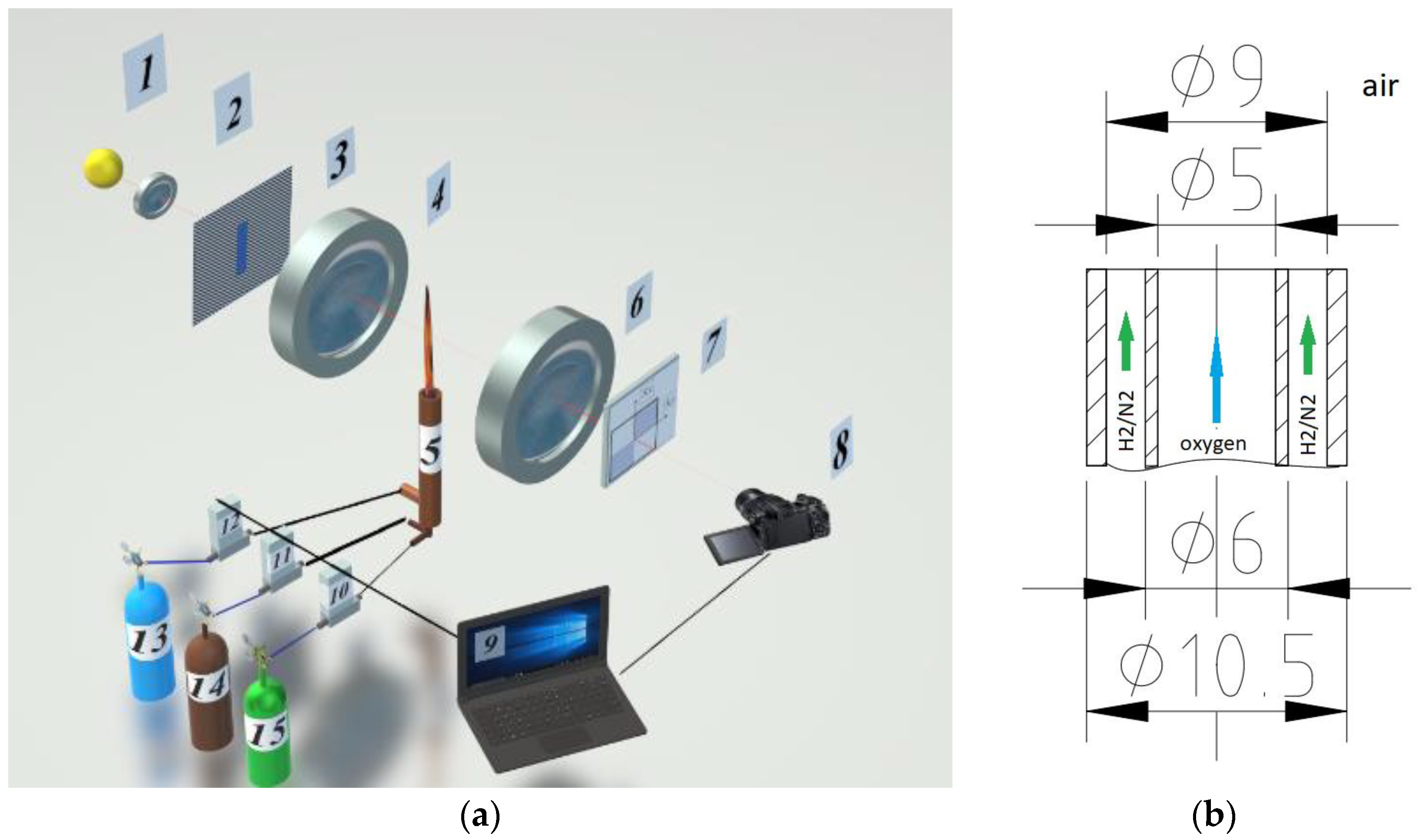
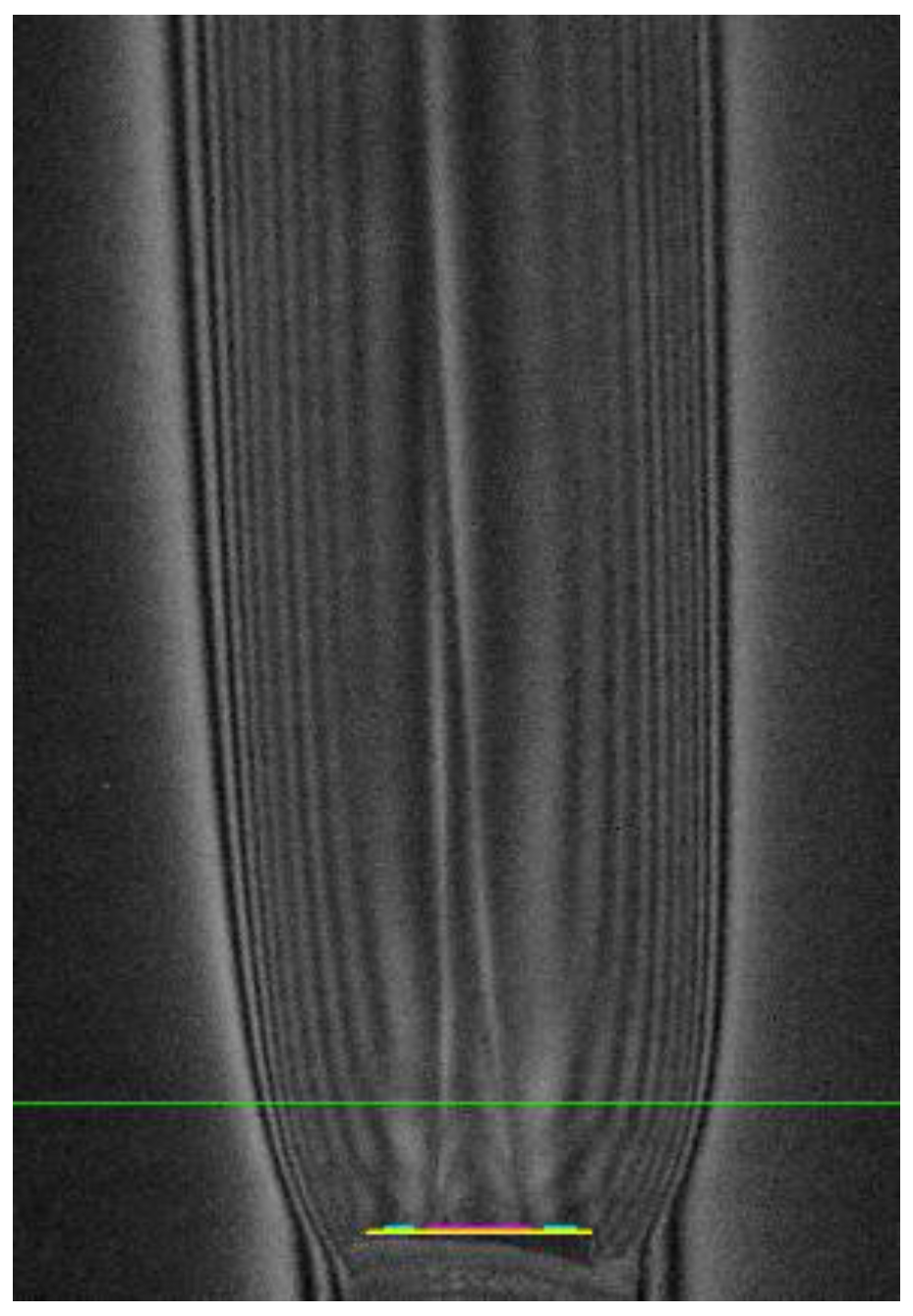
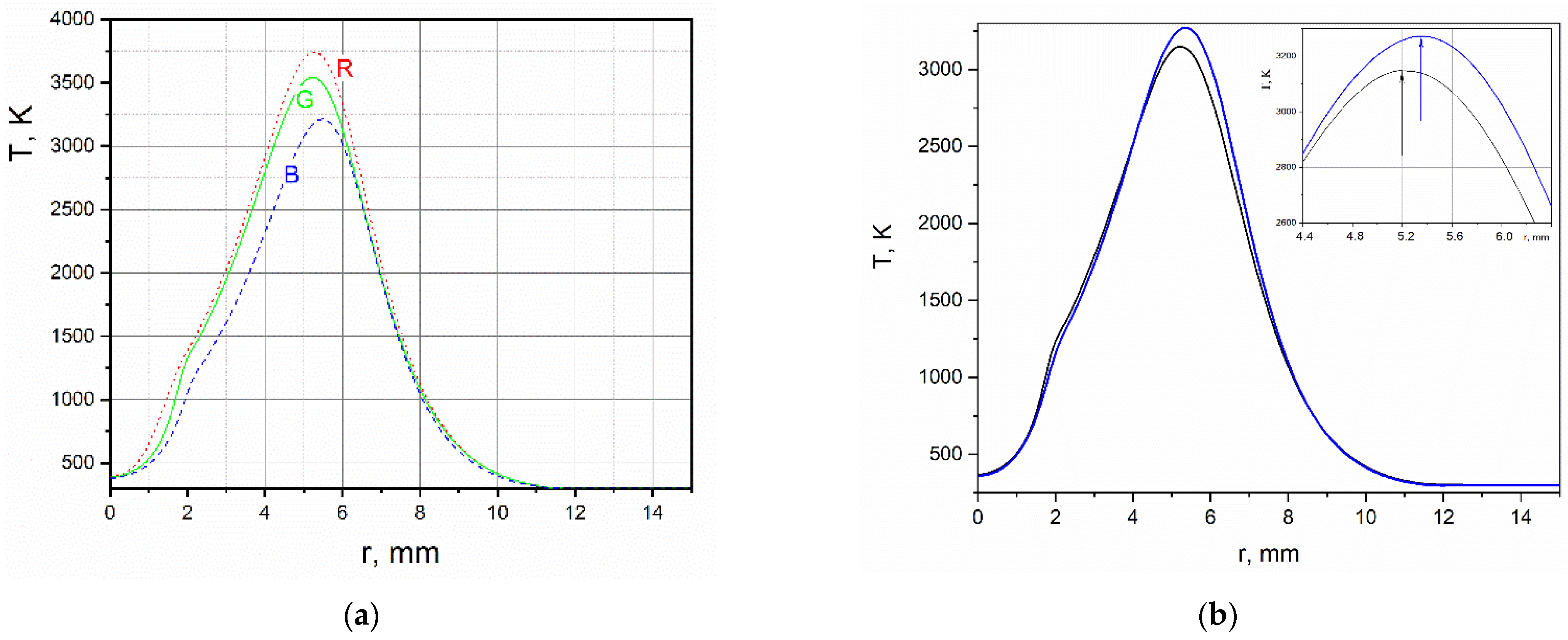
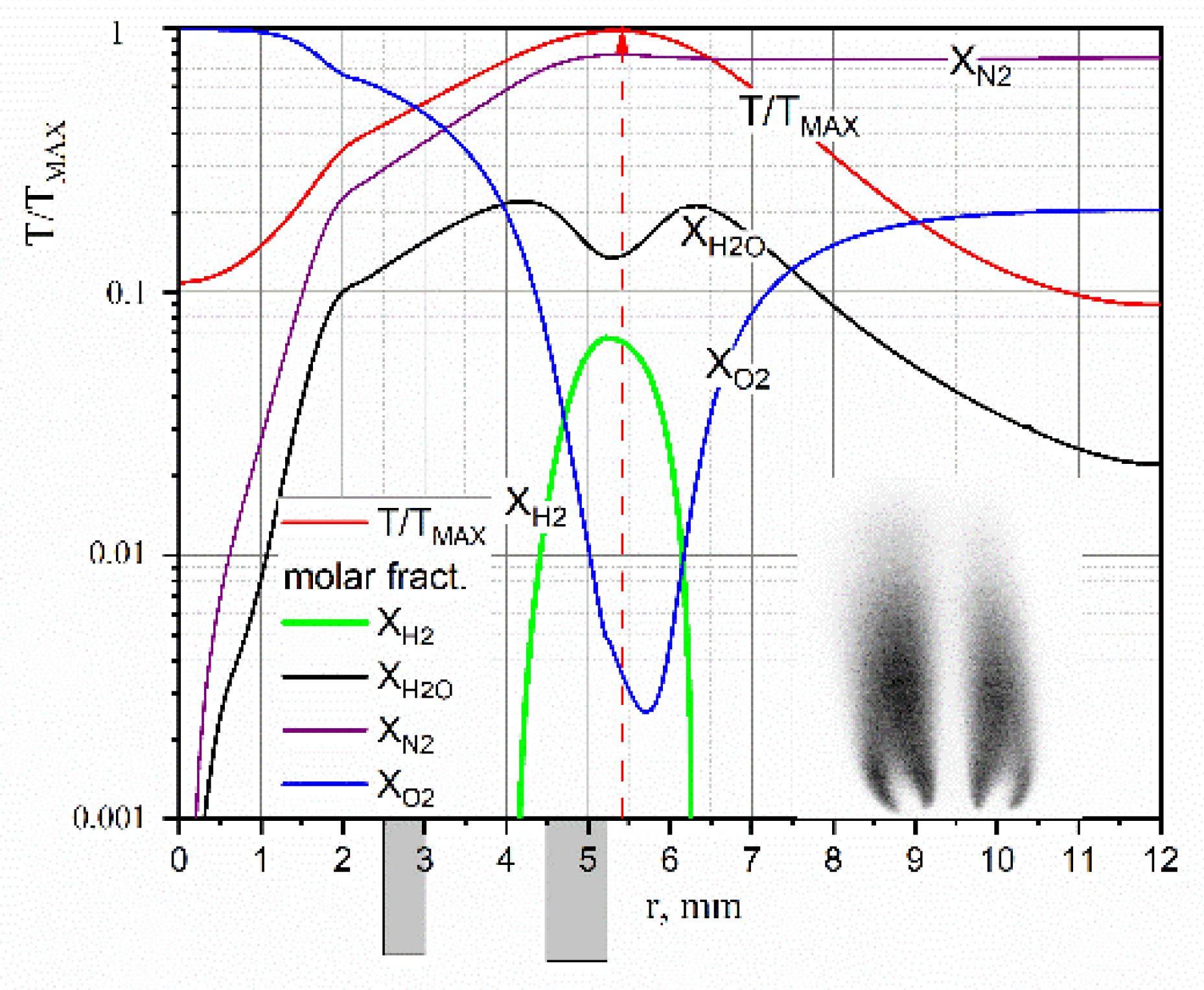
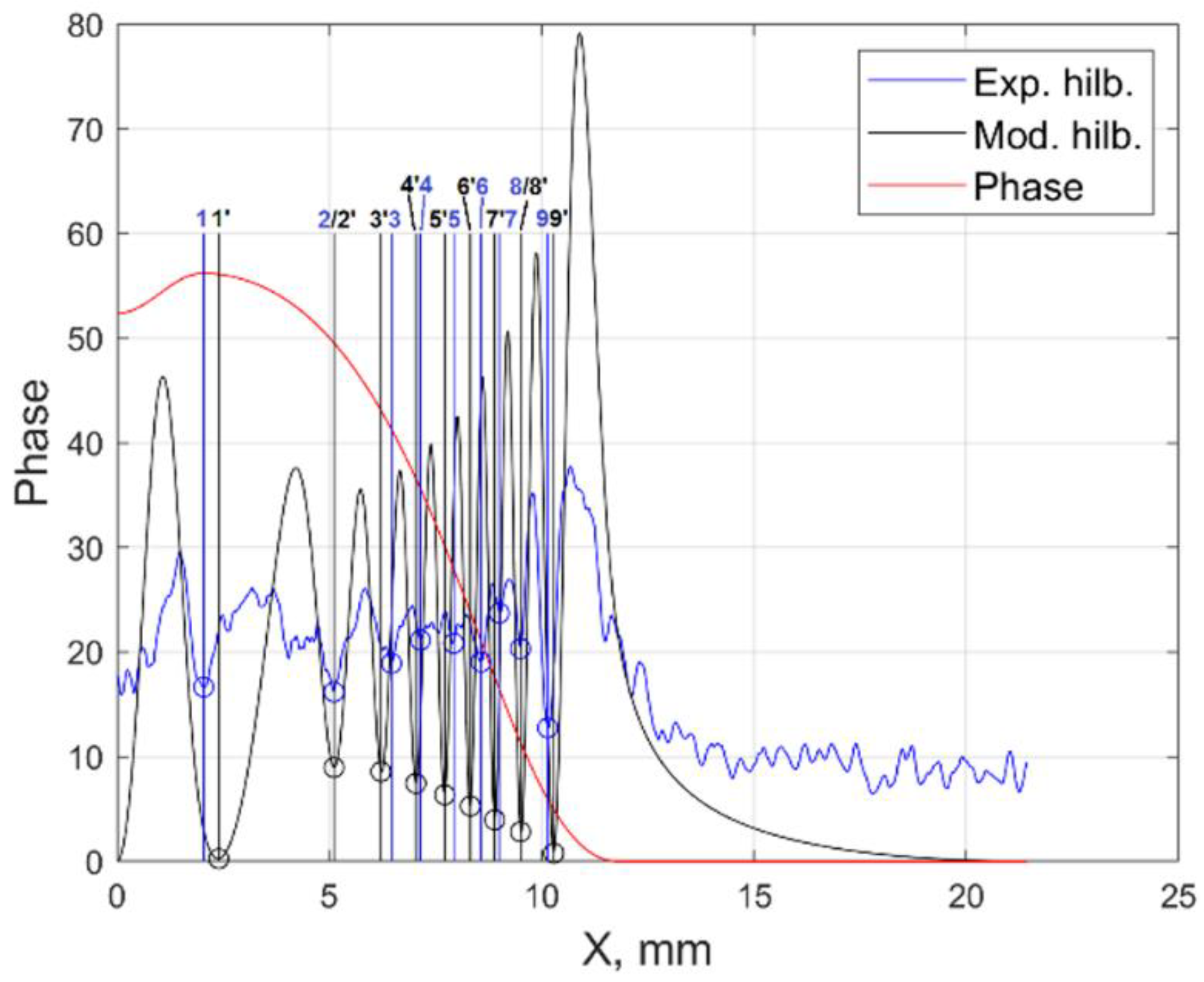

Publisher’s Note: MDPI stays neutral with regard to jurisdictional claims in published maps and institutional affiliations. |
© 2022 by the authors. Licensee MDPI, Basel, Switzerland. This article is an open access article distributed under the terms and conditions of the Creative Commons Attribution (CC BY) license (https://creativecommons.org/licenses/by/4.0/).
Share and Cite
Arbuzov, V.; Arbuzov, E.; Dubnishchev, Y.; Zolotukhina, O.; Lukashov, V.; Tupikin, A. Hilbert-Optic Diagnostics of Hydrogen-Oxygen Inverse Diffusion Flame. Energies 2022, 15, 9566. https://doi.org/10.3390/en15249566
Arbuzov V, Arbuzov E, Dubnishchev Y, Zolotukhina O, Lukashov V, Tupikin A. Hilbert-Optic Diagnostics of Hydrogen-Oxygen Inverse Diffusion Flame. Energies. 2022; 15(24):9566. https://doi.org/10.3390/en15249566
Chicago/Turabian StyleArbuzov, Vitaly, Eduard Arbuzov, Yuriy Dubnishchev, Olga Zolotukhina, Vladimir Lukashov, and Andrey Tupikin. 2022. "Hilbert-Optic Diagnostics of Hydrogen-Oxygen Inverse Diffusion Flame" Energies 15, no. 24: 9566. https://doi.org/10.3390/en15249566




